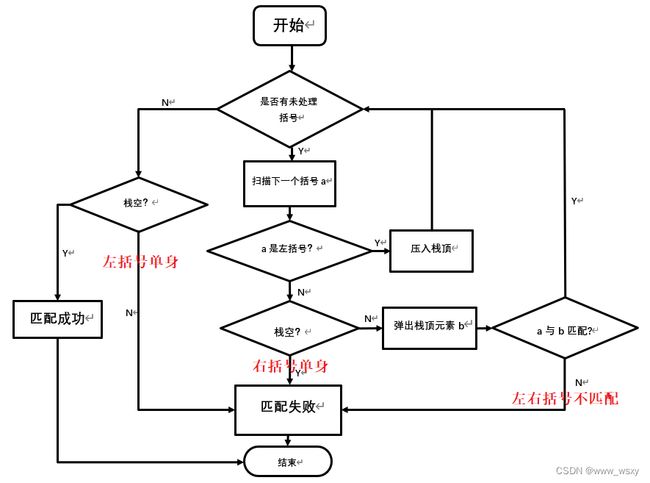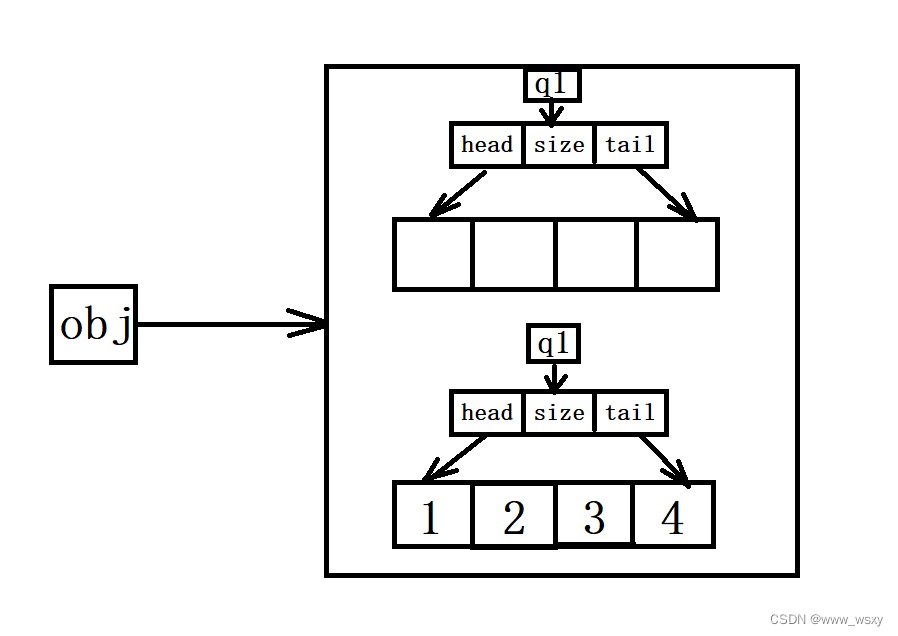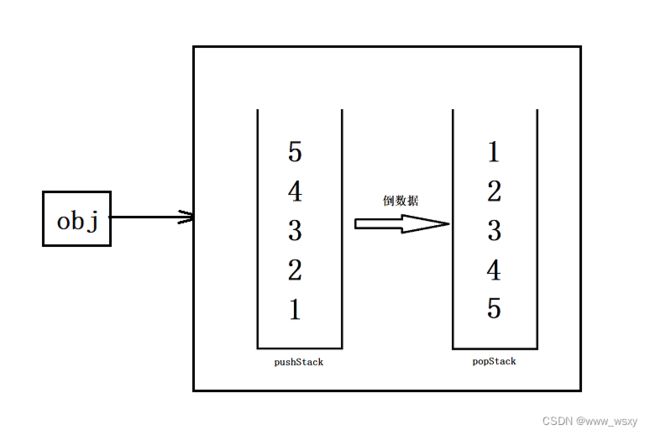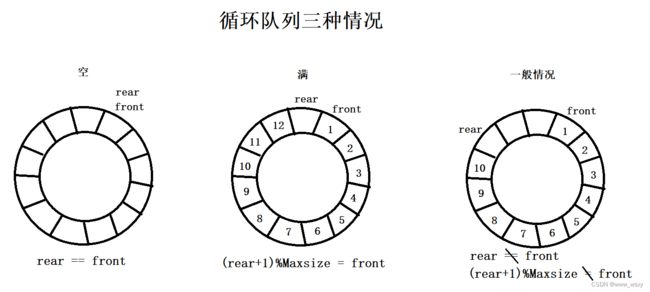栈和队列的应用
目录
- 1.括号匹配问题
-
- 1.1流程图
- 1.2代码
- 1.3复杂度
- 2.用队列实现栈
-
- 2.1思路
- 2.2画图
- 2.3代码
- 3.用栈实现队列
-
- 3.1思想
- 3.2画图
- 3.3代码
- 4.循环队列
-
- 4.1思想
- 4.2画图
- 4.3代码
1.括号匹配问题
给定一个只包括 ‘(’,‘)’,‘{’,‘}’,‘[’,‘]’ 的字符串 s ,判断字符串是否有效。
有效字符串需满足:(1)左括号必须用相同类型的右括号闭合。(2)左括号必须以正确的顺序闭合。(3)每个右括号都有一个对应的相同类型的左括号。
来源:力扣(LeetCode)
链接:https://leetcode.cn/problems/valid-parentheses/
1.1流程图
1.2代码
//使用动态数组实现栈
typedef struct SeqStack
{
char* arr;
int top;
int capacity;
}SeqStack;
//判空
bool IsEmpty(SeqStack* ps)
{
if(ps->top == -1)
return true;
return false;
}
//初始化
void InitStack(SeqStack* ps)
{
ps->arr = (char*)malloc(4*sizeof(char));
if(ps->arr == NULL)
return;
ps->top = -1;
ps->capacity = 4;
}
//进栈
void Push(SeqStack* ps,char ch)
{
if(ps->top + 1 == ps->capacity)
{
char* tmp = (char*)realloc(ps->arr,ps->capacity*2*sizeof(char));
if(tmp == NULL)
return;
ps->arr = tmp;
ps->capacity *= 2;
}
ps->arr[++ps->top] = ch;
}
//出栈
void Pop(SeqStack* ps)
{
if(ps->top == -1)
return;
ps->top--;
}
//取栈顶元素
char GetTopElement(SeqStack* ps)
{
char ch = ps->arr[ps->top];
return ch;
}
//栈的括号匹配
bool isValid(char * s){
int len = strlen(s);
SeqStack stack;
InitStack(&stack);
//遍历原数组
for(int i = 0;i < len;i++)
{
//左括号进栈
if(s[i] == '(' || s[i] == '[' || s[i] == '{')
{
Push(&stack,s[i]);
}
//右括号与栈顶元素比较
else
{
//右括号单身
if(IsEmpty(&stack))
return false;
//取栈顶元素
char ret = GetTopElement(&stack);
//三种情况左右括号不匹配
if(s[i] == ')' && ret != '(')
return false;
else if(s[i] == ']' && ret != '[')
return false;
else if(s[i] == '}' && ret != '{')
return false;
Pop(&stack);
}
}
//左括号不单身
if(IsEmpty(&stack))
return true;
//左括号单身
else
return false;
}
1.3复杂度
时间复杂度:O(n)
空间复杂度:O(1)
2.用队列实现栈
请你仅使用两个队列实现一个后入先出(LIFO)的栈,并支持普通栈的全部四种操作(push、top、pop 和 empty)。
来源:力扣(LeetCode)
链接:https://leetcode.cn/problems/implement-stack-using-queues/
2.1思路
1.用两个队列实现栈的各个功能
2.创建栈
先创建栈malloc 再初始化两个队列
3.插入(push)
将数据插入到非空队列
4.删除(pop)
将非空队列(元素个数>1)倒到另外一个空队列当中,然后非空队列只剩一个元素,此时弹出该元素,就实现栈的删除
5.取栈顶元素
取非空队列的队尾元素
6.判空
当两个队列全为空时,栈为空
7.销毁栈(destroy)
先销毁两个队列,再释放栈
2.2画图
2.3代码
//方便修改数据类型
typedef int ElemType;
//定义队列结点
typedef struct QueueNode
{
ElemType data;//数据域
struct QueueNode* next;//指针域
}QueueNode;
//封装队头指针和队尾指针
typedef struct Queue
{
QueueNode* head;
QueueNode* tail;
int size;
}Queue;
//初始化
void InitQueue(Queue* q)
{
assert(q);
q->head = q->tail = NULL;
q->size = 0;
}
//判空
bool IsEmpty(Queue* q)
{
assert(q);
if (q->size == 0)
return true;
return false;
}
//入队
void Push(Queue* q,ElemType x)
{
assert(q);
if (q->size == 0)
{
QueueNode* tmp = (QueueNode*)malloc(sizeof(QueueNode));
if (tmp == NULL)
return;
q->head = q->tail = tmp;
tmp->data = x;
tmp->next = NULL;
q->size++;
}
else
{
QueueNode* tmp = (QueueNode*)malloc(sizeof(QueueNode));
if (tmp == NULL)
return;
tmp->data = x;
tmp->next = NULL;
q->tail->next = tmp;
q->tail = q->tail->next;
q->size++;
}
}
//出队
void Pop(Queue* q)
{
assert(q && q->head);
if (q->size == 0)
return;
if (q->head == q->tail)
{
free(q->head);
q->head = q->tail = NULL;
q->size--;
}
else
{
QueueNode* del = q->head;
q->head = del->next;
q->size--;
free(del);
}
}
//取队首元素
ElemType GetHeadElement(Queue* q)
{
assert(q);
assert(!IsEmpty(q));
return q->head->data;
}
//取队尾元素
ElemType GetTailElement(Queue* q)
{
assert(q && q->head);
return q->tail->data;
}
//求队长
int QueueSize(Queue* q)
{
assert(q);
return q->size;
}
//销毁队列
void DestroyQueue(Queue* q)
{
assert(q);
QueueNode* cur = q->head;
while (cur)
{
QueueNode* tmp = cur->next;
free(cur);
cur = tmp;
}
q->head = q->tail = NULL;
q->size = 0;
}
//封装两个队列定义栈结构
typedef struct {
Queue q1;
Queue q2;
} MyStack;
//先malloc在初始化两个队列
MyStack* myStackCreate() {
//定义栈
MyStack* obj = (MyStack*)malloc(sizeof(MyStack));
//初始化队列q1和队列q2
InitQueue(&obj->q1);
InitQueue(&obj->q2);
//返回栈
return obj;
}
//进栈
void myStackPush(MyStack* obj, int x) {
//在非空队列中插入数据
if(!IsEmpty(&obj->q1))
Push(&obj->q1,x);
else
Push(&obj->q2,x);
}
//出栈
int myStackPop(MyStack* obj) {
//假设法找空队列
Queue* empty = &obj->q1;
Queue* nonempty = &obj->q2;
if(!IsEmpty(&obj->q1))
{
empty = &obj->q2;
nonempty = &obj->q1;
}
//当非空队列的元素个数>1,将其前面的元素插入到空队列当中实现倒数据
while(QueueSize(nonempty) > 1)
{
//往空队列中倒入一个元素,非空队列就删除该元素
Push(empty,GetHeadElement(nonempty));
Pop(nonempty);
}
//将非空队列的最后一个元素保存下来
int top = GetHeadElement(nonempty);
//删除非空队列的最后一个元素
Pop(nonempty);
//返回栈顶元素(非空队列的最后一个元素)
return top;
}
//取栈顶元素
int myStackTop(MyStack* obj) {
//将非空队列的队尾元素返回
if(!IsEmpty(&obj->q1))
return GetTailElement(&obj->q1);
else
return GetTailElement(&obj->q2);
}
//判空
bool myStackEmpty(MyStack* obj) {
//当两个队列同时为空,栈就为空
return IsEmpty(&obj->q1) && IsEmpty(&obj->q2);
}
//销毁栈
void myStackFree(MyStack* obj) {
//销毁队列q1和队列q2
DestroyQueue(&obj->q1);
DestroyQueue(&obj->q2);
//释放栈
free(obj);
}
3.用栈实现队列
请你仅使用两个栈实现先入先出队列。队列应当支持一般队列支持的所有操作(push、pop、peek、empty)
来源:力扣(LeetCode)
链接:https://leetcode.cn/problems/implement-queue-using-stacks/
3.1思想
1.用两个栈实现队列的各个功能
一个栈(pushStack)专门用来存数据,另外一个栈(popStack)用来删数据
2.创建队列
先创建队列malloc 再初始化两个栈
3.插入(push)
直接将元素插入到pushStack,也就是代码里的q1
4.取队首元素
将pushStack里的元素倒入到popStack中,然后再返回popStack的栈顶元素,并弹出该元素
5.删除(pop)
弹出popStack的栈顶元素
6.判空
当两个栈全为空,队列为空
7.销毁队列(destroy)
先销毁两个栈,再释放队列
3.2画图
3.3代码
//方便修改数据类型
typedef int ElemType;
//定义栈结构
typedef struct SeqStack
{
ElemType* a;
int top;//栈顶指针
int capacity;//栈容量
}SeqStack;
//判空
bool IsEmpty(SeqStack* ps)
{
//为什么assert,非常规思维
assert(ps);
if (ps->top == -1)
return true;
return false;
}
//初始化
void InitStack(SeqStack* ps)
{
assert(ps);
ps->a = (ElemType*)malloc(4 * sizeof(ElemType));
if (ps->a == NULL)
{
return;
}
ps->top = -1;
ps->capacity = 4;
}
//取栈顶元素
ElemType GetTopElement(SeqStack* ps)
{
assert(ps);
ElemType x = ps->a[ps->top];
return x;
}
//求栈长
int StackLength(SeqStack* ps)
{
assert(ps);
return ps->top + 1;
}
//进栈
void StackPush(SeqStack* ps, ElemType x)
{
assert(ps);
if (StackLength(ps) == ps->capacity)
{
ElemType* tmp = (ElemType*)realloc(ps->a, ps->capacity * 2 * sizeof(ElemType));
if (tmp == NULL)
{
return;
}
ps->a = tmp;
ps->capacity *= 2;
}
ps->a[++ps->top] = x;
}
//出栈
void StackPop(SeqStack* ps)
{
assert(ps);
if (IsEmpty(ps))
return;
ps->top--;
}
//销毁栈
void DestroyStack(SeqStack* ps)
{
assert(ps);
free(ps->a);
ps->a = NULL;
ps->capacity = 0;
ps->top = -1;
}
//定义两个栈创建队列
typedef struct {
SeqStack q1;
SeqStack q2;
} MyQueue;
//创建队列再初始化两个栈
MyQueue* myQueueCreate() {
//创建队列
MyQueue* obj = (MyQueue*)malloc(sizeof(MyQueue));
//初始化两个栈
InitStack(&obj->q1);
InitStack(&obj->q2);
//返回队列
return obj;
}
//入队
void myQueuePush(MyQueue* obj, int x) {
assert(obj);
StackPush(&obj->q1,x);
}
//出队
int myQueuePop(MyQueue* obj) {
assert(obj);
int peek = myQueuePeek(obj);
StackPop(&obj->q2);
return peek;
}
//取队首元素
int myQueuePeek(MyQueue* obj) {
assert(obj);
//如果popStack为空且pushStack不为空
//就将pushStack的元素倒入到popStack当中
if(IsEmpty(&obj->q2))
{
while(!IsEmpty(&obj->q1))
{
//将pushStack当中的元素倒入到popStack当中
StackPush(&obj->q2,GetTopElement(&obj->q1));
//弹出pushStack的栈顶元素
StackPop(&obj->q1);
}
}
//返回队首元素(也就是popStack当中的栈顶元素)
return GetTopElement(&obj->q2);
}
//判空
bool myQueueEmpty(MyQueue* obj) {
assert(obj);
//当两个栈同时为空时,队列为空
return IsEmpty(&obj->q1) && IsEmpty(&obj->q2);
}
//销毁队列
void myQueueFree(MyQueue* obj) {
assert(obj);
//先销毁两个栈
DestroyStack(&obj->q1);
DestroyStack(&obj->q2);
//释放队列
free(obj);
}
4.循环队列
设计你的循环队列实现。 循环队列是一种线性数据结构,其操作表现基于 FIFO(先进先出)原则并且队尾被连接在队首之后以形成一个循环。它也被称为“环形缓冲器”。
循环队列的一个好处是我们可以利用这个队列之前用过的空间。在一个普通队列里,一旦一个队列满了,我们就不能插入下一个元素,即使在队列前面仍有空间。但是使用循环队列,我们能使用这些空间去存储新的值。
来源:力扣(LeetCode)
链接:https://leetcode.cn/problems/design-circular-queue
4.1思想
使用链表或者数组实现循环队列,因为前者不能随机访问,所以我们选择用数组实现循环队列。循环队列头尾相连,大小固定。
两大问题:
1.如何判空判满
(1)增加加一个计数变量(size)
(2)创建一个空结点
2.如何用数组实现循环
(1)特殊处理
if(rear == Maxsize) rear = 0;
(2)循环取模
(rear + 1) % Maxsize
4.2画图
4.3代码
//定义循环队列结构
typedef struct {
int* arr;//数组
int front;//队头指针
int rear;//队尾指针
int k;//循环队列有效元素个数
} MyCircularQueue;
//创建循环队列(队列总大小为k+1)
MyCircularQueue* myCircularQueueCreate(int k) {
//创建循环队列
MyCircularQueue* obj = (MyCircularQueue*)malloc(sizeof(MyCircularQueue));
//开辟k+1个数组元素
obj->arr = (int*)malloc((k+1)*sizeof(int));
//置空
obj->front = obj->rear = 0;
//循环队列有效元素个数
obj->k = k;
//返回循环队列
return obj;
}
//判空
bool myCircularQueueIsEmpty(MyCircularQueue* obj) {
assert(obj);
if(obj->front == obj->rear)
return true;
return false;
}
//判满
bool myCircularQueueIsFull(MyCircularQueue* obj) {
assert(obj);
if((obj->rear + 1)%(obj->k + 1) == obj->front)
return true;
return false;
}
//入队
bool myCircularQueueEnQueue(MyCircularQueue* obj, int value) {
assert(obj);
//判满
if(myCircularQueueIsFull(obj))
return false;
//存值
obj->arr[obj->rear] = value;
//循环
obj->rear = (obj->rear + 1) % (obj->k + 1);
return true;
}
//出队
bool myCircularQueueDeQueue(MyCircularQueue* obj) {
assert(obj);
//判空
if(myCircularQueueIsEmpty(obj))
return false;
//循环
obj->front = (obj->front + 1) % (obj->k + 1);
return true;
}
//取队首元素
int myCircularQueueFront(MyCircularQueue* obj) {
assert(obj);
//判空
if(myCircularQueueIsEmpty(obj))
return -1;
//取值
return obj->arr[obj->front];
}
//取队尾元素
int myCircularQueueRear(MyCircularQueue* obj) {
assert(obj);
//判空
if(myCircularQueueIsEmpty(obj))
return -1;
//找到rear的前一个结点
int rear = (obj->rear + obj->k) % (obj->k + 1);
return obj->arr[rear];
}
//销毁循环队列
void myCircularQueueFree(MyCircularQueue* obj) {
assert(obj);
//先释放开辟的k+1个数组大小的空间
free(obj->arr);
//再释放开辟的结构体变量
free(obj);
}




